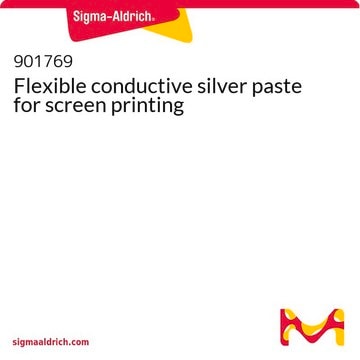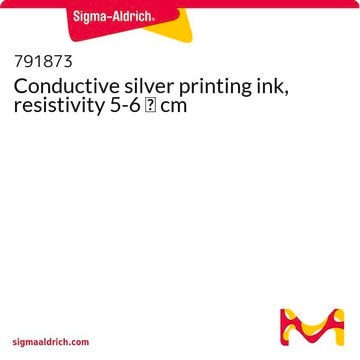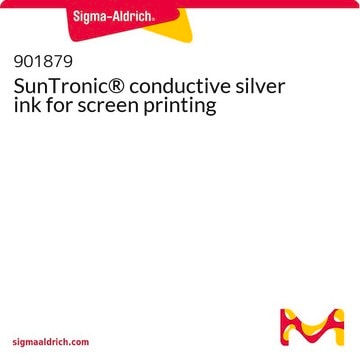This platinum paste has initially been developed as a screen printing paste to obtain a highly conductive and “catalytic” amount of platinum when printed on a transparent substrate (glass, plastics), while allowing the substrates to maintain their transparency after deposition and annealing. The concentration of platinum is therefore quite low (<1%), and the screen printed layer is usually quite thin. Any changes to the product would be for the researcher to experiment with. This paste must be fired at or above 420°C and any modifications made to the product does void the performance guarantee.
791512
Platinum paste, screen printable
Sinônimo(s):
Greatcell Solar PT1 platinum paste, Pt paste, conductive paste
Selecione um tamanho
Selecione um tamanho
About This Item
Produtos recomendados
Formulário
paste (Amber)
Nível de qualidade
viscosidade
2500-4500 mPa.s (Analysis carried out at 20°C with 20mm 4 degree cone/plate; 40 s-1)
temperatura de armazenamento
2-8°C
cadeia de caracteres SMILES
[Pt]
InChI
1S/Pt
chave InChI
BASFCYQUMIYNBI-UHFFFAOYSA-N
Categorias relacionadas
Aplicação
PT1 Platinum Paste is oil-based and formulated to be applied using a screen printer; providing films with excellent uniformity; performance and reproducibility; and can be used for DSSC polot production.
After drying; this paste must be fired at or above 420°C. This results in uniformly distributed platinum nanoclusters; providing good transparency and high catalytic activity for the electrochemical reduction of I3- to I-.
Suggested Mesh Screen: 100T
Informações legais
Greatcell Solar is a registered trademark of Greatcell Solar Materials Pty Ltd
Palavra indicadora
Danger
Frases de perigo
Declarações de precaução
Classificações de perigo
Eye Dam. 1 - Resp. Sens. 1 - Skin Irrit. 2 - Skin Sens. 1
Código de classe de armazenamento
10 - Combustible liquids
Classe de risco de água (WGK)
WGK 1
Ponto de fulgor (°F)
194.0 °F
Ponto de fulgor (°C)
90 °C
Escolha uma das versões mais recentes:
Já possui este produto?
Encontre a documentação dos produtos que você adquiriu recentemente na biblioteca de documentos.
Os clientes também visualizaram
Artigos
Dye-sensitized solar cells (DSCs) are 3rd generation solar cells combining the promise of high efficiency with low production costs.
While dye sensitization as the basis for color photography has been accepted for a very long time,1 attempts to use this principle for the conversion of solar light to electricity generally had resulted only in very low photocurrents, below 100 nA/cm
Professors Tokito and Takeda share design principles and optimization protocols for organic electronic devices, focusing on flexibility and low cost.
Progress in solution-processed functional materials leads to thin-film optoelectronic devices for industrial and consumer electronics.
-
Can the paste be thinned using solvent? If so, which? Also, will be paste become solid if cured underneath the 420degC temperature? And would it adhere to a polymer substrate? Thanks!
1 answer-
Helpful?
-
-
Does it work as a conductive paste? Do you have the resistivity of the paste?
1 answer-
Unfortunately, Product 791512 has not been tested for its properties in terms of conductivity or resistivity. Rather, it was developed for its catalytic properties.
Helpful?
-
Active Filters
Nossa equipe de cientistas tem experiência em todas as áreas de pesquisa, incluindo Life Sciences, ciência de materiais, síntese química, cromatografia, química analítica e muitas outras.
Entre em contato com a assistência técnica












